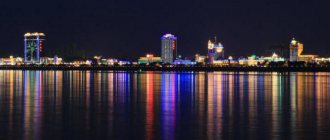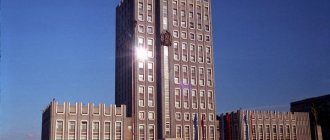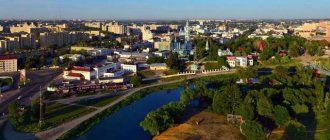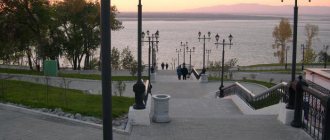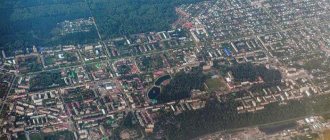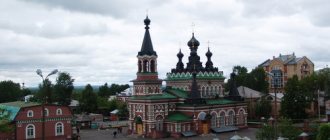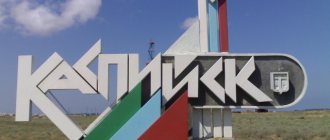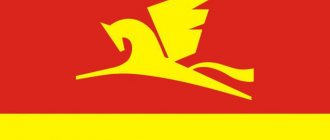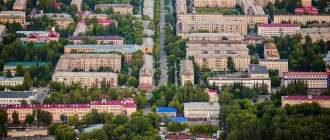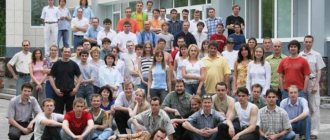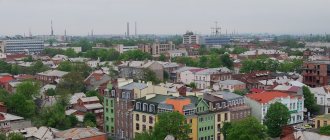City `s history
The city has an ancient history. A couple of sites from the Stone Age era (15.5 thousand years ago) were discovered here. There are also remains of Bronze Age villages. In the historical past, the first settlements appeared in the 10th century, during the formation of Volga Bulgaria. Active settlement of the area took place in the 13th-14th centuries. The city itself was built relatively recently - in 1960, which was associated with the founding of a chemical plant. Its size increased very quickly. In 1983 the population was 100,000.
Culture and art
To satisfy the spiritual needs of residents, 20 cultural objects operate in the city. The largest of them is the Khimik Palace of Culture with an auditorium for 800 seats, which opened on November 2, 1971.
- DK Khimik
- Children's art school
- Art school
- School of Music
- Park of Culture and Recreation Elnikovskaya Grove
Theaters and cinemas
- Chuvash State Experimental Drama Theater
- Mime theater "Rain"
- Cinema Atal
Libraries
- Central City Library named after. Yu. Gagarin
- City Model Library named after. N. I. Polorussova-Shelebi
- Library named after P. Khuzangaya (branch no. 2)
- Model library of family reading named after. A. Nikolaeva
- Family Reading Library named after. S. Ya. Marshak
- City model children's and youth library
- Library named after N.Nosova
- Family Reading Library named after. V. I. Davydova-Anatri
- Library-museum
Museums
Art Museum
Founded in 1983 as a showroom. In 1996, the exhibition hall was transformed into the municipal cultural institution “Art Museum”.
The museum fund includes 651 works by Russian artists. The museum fund consists of 843 storage units: painting, graphics, sculpture, decorative and applied and folk art. The museum offers visitors tours of exhibitions, lectures on art, the history of the city, and its pioneers. It also conducts professional meetings “Secrets of Craft” with masters of fine art and folk craftsmen, as well as poetic, musical and literary evenings.
Museum of the History of Novocheboksarsk
Founded in 2008. A young developing city with an already established rich history has something to tell and show in the exhibitions of the new museum. The administration and archive of the museum are located on the ground floor of the building, and exhibitions are located above. The history of Novocheboksarsk is presented in three halls, which represent the past, present and future of the city.
Geographical features
The city is located 17 kilometers from the capital of the Chuvash Republic, Cheboksary, on the right bank of the Volga. It is a significant transport and economic center. It has an important freight railway, a river port and a bridge across the Volga.
Novocheboksarsk is located in the Moscow time zone (MSK).
The city is located on a slightly hilly undulating plain, which is dissected by river valleys, streams and ravines. Landslides often occur here, with the formation of ravines, wetlands and flooding of low-lying areas.
The environmental situation in the city varies by region. In the industrial part it is significantly worse. Vehicle emissions also affect the level of air pollution.
Team Nomads
Novocheboksarsk began to be built in 1960, when satellite cities were created around large cities. Initially it was called “Sputnik”. They began to build it on areas free from development. As it grew, it absorbed the surrounding villages - Elnikovo, Yandashevo, Anatkasy, Tsygankasy, etc. On December 27, 1971, the Presidium of the Supreme Soviet of the RSFSR made a gift to the people of Novocheboksarsk by issuing a Decree “On classifying the city of Novocheboksarsk of the Chuvash Autonomous Soviet Socialist Republic as a city of republican (CHASSR) subordination)” . Its territory is 36.7 sq. km.
Located 21 km from the capital of the Chuvash Republic - Cheboksary. The city limits were approved in December 1998. The economic and geographical position of both cities has much in common. They are served by common modes of transport. They have a common construction and energy base, common water supply and water treatment systems. Currently, there are close economic, cultural and everyday ties between the two cities.
ARTICLE ABOUT CHEBOKSARY RESERVOIR - HERE!
SPRINGS AND SOURCES OF CHUVASHIA - HERE!
ATTRACTIONS OF CHUVASHIA - HERE!
NATURAL MONUMENTS OF CHUVASHIA - HERE!
REPUBLIC OF CHUVASHIA - GENERAL INFORMATION - HERE!
ANOMAL AREAS OF CHUVASHIA - HERE!
RIVERS OF CHUVASHIA - HERE!
Novocheboksarsk is one of the most comfortable and beautiful cities in the republic. It was built according to the latest projects of Leningrad architects. One of its first and main thoroughfares is Vinokurova Street, on which in 1985 a monument was erected to the fighter for the establishment of Soviet power in Chuvashia I.S. Semenov. The city is also decorated with modern monuments. One of them, on Gidrostroiteley Boulevard, was erected in memory of the residents of villages that were previously located on the site of Novocheboksarsk who died during the Great Patriotic War. The second is the Church of the Holy Equal-to-the-Apostles Prince Vladimir, First Baptist of Rus'. The city was built and expanded at a very fast pace. Already in 1978, a meeting was held dedicated to the commissioning of the first million square meters of housing, and five years later, on October 29, 1983, the hundred thousandth resident was born. The city is divided into 3 residential areas: East, South, West. There are 18 microdistricts.
CHRONICLE OF THE CITY On November 18, 1960, a team of concrete workers from V.N. Nikiforov “Stroytrest N4” laid the first cubic meters of concrete in the foundation of the first house (now house No. 18 on Kommunisticheskaya Street.) This street did not immediately receive this name. On July 5, 1962, the Executive Committee of the Cheboksary City Council decided: “The first street, built up with multi-storey buildings parallel to the protective zone from the brick factory in the city of Sputnik (New Industrial District), should be named after Kurchatov, the famous atomic physicist, and henceforth be called Kurchatov Street.” And only on July 12, 1962 In 2009, the Cheboksary City Executive Committee decided “to change the previously made decision, to name the first street in the Novopromyshlenny district Kommunisticheskaya.” The grand opening of the first street took place. Our city originates from it. Here, almost every building is given the epithet “first”: the first house and the first school, the first club and the first library, the first bathhouse and the first restaurant, the first city market and the first passenger depot, etc. In those distant 60s, when Novocheboksarsk was not yet on geographic maps, people dreamed of a new, beautiful, bright, comfortable city. And their dream became clear. The city of Sputnik was being built and taking on visible shape. Working, energetic people carried it into orbit with reliable, tireless hands. Novocheboksarsk, which arose as part of the city of Cheboksary, was its satellite for the first 5 years. July 6, 1965. The Bureau of the Chuvash Regional Committee of the CPSU adopted a resolution “On the formation of the city of Ilyichevsk of republican (ASSR) subordination,” providing for the formation of a chemical plant on the right bank of the river on the basis of a residential area. Volga of the city of Ilyichevsk. On August 11, 1965, the Bureau of the Chuvash Regional Committee of the CPSU adopted a resolution “On the creation of the city of Novocheboksarsk” which, in particular, stated: “In amending its resolution of July 6, 1965, the regional committee bureau decides: 1. On the basis of the Novocheboksarsk district, to form the city of Novocheboksarsk city Cheboksary subordination." On August 11, 1965, the Presidium of the Supreme Council of the Czechoslovak Autonomous Soviet Socialist Republic adopted a resolution “On the formation of the city of Novocheboksarsk in the Chuvash Autonomous Soviet Socialist Republic,” which abolished the Bannovsky village council of Cheboksary, transferring the settlements of Bannovo, Ivanovo, Oldeevo, Tenekassy, Chedino and Yandashevo to the administrative subordination of the Novocheboksary city council. September 27, 1965. The Presidium of the Supreme Soviet of the RSFSR adopted the Decree “On the transformation of a village during the construction of a plant in the suburban area of the city of Cheboksary of the Chuvash Autonomous Soviet Socialist Republic into a city of district subordination.” December 27, 1971. The Presidium of the Supreme Soviet of the RSFSR adopted the Decree “On classifying the city of Novocheboksarsk to the category of cities of republican (ASSR) subordination.” In 1977, an art school was opened at secondary school No. 6. There are 160 students studying in its three departments of choreography, art, and music. In 1979, a furniture repair and manufacturing factory was opened. In 1980, the opening of the first stage of the Novocheboksarsk sports complex took place. In 1988, a bus station was opened in the Elnikovsky microdistrict, which has convenient exits to main highways. In 1992, the first library of national and spiritual revival in the republic was opened. Visitors can not only get acquainted with the latest books, but also watch performances of folklore ensembles recorded on a video recorder. In September 1992, Russian President B.N. Yeltsin visited the city.
2003 On February 24, 1993, by decision of the city Council of People's Deputies, the coat of arms of the city of Novocheboksarsk, artist V.I. Razin, was approved. The coat of arms of the city of Novocheboksarsk is an image of a golden bordered heraldic shield with red stylized ornamental Chuvash symbols. The coat of arms is crowned with the “three suns” emblem, which symbolizes belonging to the Chuvash Republic. The ornamental symbolism in the center figuratively expresses the owner of the city, chemists and electric power workers. The shield is bordered with azure color. 2005 By the decision of the Novocheboksarsk City Assembly of Deputies dated February 9, 2005, a new coat of arms and flag of Novocheboksarsk were approved. Heraldic description of the Coat of Arms: In an intersected field of azure and green, there is a wide lowered golden rafter, burdened with three flying azure ducks holding green oak branches in their beaks. Heraldic description of the Flag: A rectangular yellow panel with a height to length ratio of 2:3. Adjacent to the upper corners are two blue fields in the shape of right triangles, the legs of which are the sides of the panel (the length of the legs: along the top edge of the panel - 1/2 the length of the panel, along the side edges of the panel - 2/3 of the height of the panel). Adjacent to the bottom edge of the panel is a green field in the shape of an isosceles triangle, the base of which is the bottom edge of the panel, the sides are parallel to the hypotenuses of the blue fields, the top is located on the vertical axis of the panel, and the height is 1/3 of the height of the panel. On the yellow part of the panel there are three azure ducks flying towards the tree, holding green oak branches in their beaks: one in the center and two below it, close to the lower corners of the panel. On March 23, 2005, the city's coat of arms and flag were entered into the State Heraldic Register. Until 2010, City Day was celebrated on November 18. By decision of the Novocheboksarsk City Assembly of Deputies dated July 19, 2010 No. C 82-2, a new official annual date for the City Day of Novocheboksarsk was determined; from 2010, the City Day of Novocheboksarsk will be celebrated on the third Saturday of September.
GENERAL INFORMATION Novocheboksarsk (Chuvash. Ҫӗнӗ Shupashkar) is a city in the Chuvash Republic in the Russian Federation.
The population of the city is 125,489 people. (2016). The population of the urban district is 125,797 people. (2016).
Located 17 km from the capital of the Chuvash Republic - Cheboksary, on the right bank of the Volga River. It has an advantageous transport and geographical position, since the dam of the Cheboksary hydroelectric power station also serves as a road bridge (put into operation on July 29, 1994) providing communication with Yoshkar-Ola, Kazan and other cities in the northern part of the Volga-Vyatka region. The city has its own river port, which carries out freight and passenger transportation. The freight railway turned Novocheboksarsk into one of the major economic centers on the Volga.
The city limits were approved in December 1998. The city is divided into three residential areas: East, South, West. There are 18 microdistricts.
On March 2, 2008, a referendum was held to unite the cities of Cheboksary and Novocheboksarsk into one urban district. The majority of Novocheboksary residents voted against the unification.
GEOGRAPHY OF THE CITY The city of Novocheboksarsk with the entire complex of industrial enterprises is located on the right bank of the Volga River, within the interfluve of the Tsivil and Kukshum rivers. The channel of the latter limits the territory from the west and south, the northern border is the Volga River, and the eastern border is the Tsivil River. The area of the city is 51.4 square kilometers. Novocheboksarsk has a favorable geographical position, located 14 km. from the capital of the Chuvash Republic - Cheboksary. In the vicinity of the city there are significant deposits of brick and expanded clay raw materials, construction sands, and peat, which favors the development of the building materials industry. The climate of the city is temperate continental with all its inherent features: moderately hot summers and cold winters with unstable weather, with frequent precipitation in the form of rain and snow, fog and sunny days. In summer the temperature on average reaches 25-35 degrees, in winter – 20-25 degrees. However. Every year winter becomes milder, heat is mainly carried by southern and southwestern winds, rain and cold are carried by northern and northwestern cyclones. The relief is an undulating, sometimes hilly plain, dissected by the valleys of the Kukshum rivers, streams and numerous ravines. Exogenous geological processes are developed in the city area: gully formation, landslide processes, waterlogging, flooding of low-lying areas. The city has a favorable transport location.
The latitudinal city-wide highway connecting the city of Novocheboksarsk with the city of Cheboksary goes out onto the federal highway “Vyatka”, which connects Chuvashia with the Republic of Mari-El. The same road provides the shortest route from Novocheboksarsk to other federal highways: Volga and Tsivilsk - Ulyanovsk. Transport communication with the neighboring Marposad district is carried out along the main republican highway Novocheboksarsk - Marposad - Volga. The nearest railway stations of the Gorky Railway Administration are Art. Cheboksary and st. Kanash. The railway access from the industrial zone of Novocheboksarsk is adjacent to the Kanash-Cheboksary line. In the industrial zone there are stations. Industrial and Art. Passenger Street, which is adjacent to the access roads of city enterprises. There are no railway approaches to the quay walls of enterprises located along the Kuibyshev Reservoir. River communication along the Volga River and reservoirs is carried out by the Cheboksary river port within the boundaries of Ilyinka-Kozlovka. Suburban, intracity and intercity passenger services have been organized. The cargo area of the Novocheboksary port with berth walls 208 meters long is located 3 km below the Cheboksary hydroelectric station. The main cargo arriving by water transport is inert building materials, sand, crushed stone, gravel for road and construction work not only in the Chuvash Republic, but also in other neighboring regions.
HISTORY OF THE CITY The land occupied by Novocheboksarsk has an ancient history. In this area, archaeologists discovered two sites of ancient people dating back to the Stone Age - the Mesolithic (13.5 thousand years BC) and the Neolithic (4-3 thousand years BC). The first parking lot is located along the left bank of the river. Tsivil - former village. Yandashevo (now within the city), the second is above the mouth of the river. Civil on the banks of the Volga (village of Ivanovo).
There are Bronze Age mounds near the villages of Yurakovo and Bannovo (now within the boundaries of Novocheboksarsk). There was a Bronze Age settlement near the village. Yandashevo.
According to archaeological data, along the river. Great Civil Chuvash villages began to appear in the 10th century. - the time of the formation of Volga Bulgaria. In the XIII-XIV centuries. There was a continuous settlement of the basin of the Greater and Lesser Civilizations by the Bulgaro-Chuvash.
Novocheboksarsk began to be built in 1960 in connection with the construction of a chemical plant. With the growth of the city, surrounding villages were included in it - Bannovo, Elnikovo, Yandashevo, Anatkasy, Tsygankasy, Ivanovo, Chedino, Yurakovo and a number of others. The city's birthday is considered to be November 18, 1960. Initially they wanted to name the city Ilyichevsk, but on August 11, 1965, the Presidium of the Supreme Council of the Chuvash Autonomous Soviet Socialist Republic adopted a resolution “On the formation of the city of Novocheboksarsk in the Chuvash Autonomous Soviet Socialist Republic.” On September 27, 1965, based on the Decree of the Presidium of the Supreme Soviet of the RSFSR, Novocheboksarsk received city status. On December 27, 1971, the Presidium of the Supreme Soviet of the RSFSR issued a Decree “On classifying the city of Novocheboksarsk of the Chuvash Autonomous Soviet Socialist Republic as a city of republican (CHASSR) subordination.”
The city was built and expanded at a very fast pace. Already in 1978, a meeting was held dedicated to the commissioning of the first million square meters of housing, and five years later, on October 29, 1983, the hundred thousandth resident was born. The city of Novocheboksarsk, like the entire Chuvash Republic, is located in a time zone designated by international standard as the Moscow Time Zone (MSK). The offset relative to UTC is +3:00. Time in Novocheboksarsk corresponds to geographic standard time. Climate The climate of the city is temperate continental with all its inherent features: moderately hot summers and cold winters with unstable weather, with frequent precipitation in the form of rain and snow, fog and sunny days. In summer the temperature on average reaches 25-35 degrees, in winter - 20-25 degrees. Every year winter becomes milder, heat is mainly carried by southern and southwestern winds, rain and cold are carried by northern and northwestern cyclones. Coat of arms of Novocheboksarsk The author of the coat of arms of Novocheboksarsk is local heraldist Vadim Anatolyevich Shipunov. The coat of arms was approved on February 9, 2005 and entered into the State Heraldic Register under No. 1799.
“A golden rafter laden with three flying ducks holding green oak branches in their beaks.”
1993 The previous coat of arms of the city was approved in 1993.
“The coat of arms of the city of Novocheboksarsk is an image of a golden bordered heraldic shield with red stylized ornamental Chuvash symbols. The coat of arms is topped with the “three suns” emblem, which symbolizes belonging to the Chuvash Republic. The ornamental symbolism in the center figuratively expresses the mistress of the city of chemists and electric power workers. The shield is bordered with azure color" (description of the coat of arms). The author of the coat of arms is V. I. Razin.
Flag of Novocheboksarsk Heraldic description of the Flag: “A rectangular panel of yellow color with a height to length ratio of 2:3. Adjacent to the upper corners are two blue fields in the shape of right triangles, the legs of which are the sides of the panel (the length of the legs: along the top edge of the panel - 1/2 the length of the panel, along the side edges of the panel - 2/3 of the height of the panel). Adjacent to the bottom edge of the panel is a green field in the shape of an isosceles triangle, the base of which is the bottom edge of the panel, the sides are parallel to the hypotenuses of the blue fields, the top is located on the vertical axis of the panel, and the height is 1/3 of the height of the panel. On the yellow part of the panel there are three azure ducks flying towards the tree, holding green oak branches in their beaks: one in the center and two below it, close to the lower corners of the panel.” (flag description).
Industry Novocheboksarsk is a modern city of chemists, energy workers and builders. The leading city-forming enterprise is the joint-stock company "Khimprom". For almost two decades, the Cheboksary hydroelectric power station, built on the Volga, near the city, has been operating, generating electricity for the republic and neighboring regions. The industrial potential of Novocheboksarsk includes 219 enterprises of all forms of ownership, including 18 main ones.
The city has a well-developed construction complex, which at one time made it possible to build not only Khimprom and the Cheboksary hydroelectric power station, but also modern residential areas with developed social infrastructure. Its housing stock alone amounts to 2 million square meters.
In recent years, in Novocheboksarsk, as well as throughout the republic, processes of economic reform, its structural restructuring are actively underway, and market relations are strengthening. Industrial enterprises, primarily JSC Khimprom and the Cheboksary Hydroelectric Power Station, are overcoming the economic difficulties associated with the new form of management. Production is reviving and production is increasing. Small businesses are also developing, and there are more entrepreneurs every year. Transport The Novocheboksarsk-Cheboksary-2 freight railway, the federal road P176 “Vyatka”, as well as the shipping route along the Volga River pass through the city. In the industrial zone there are stations. Industrial and Art. Passenger Street, which is adjacent to the access railway tracks of city enterprises. Transport communication with the neighboring Marposad district is carried out along the main republican highway Novocheboksarsk - Marposad - Volga. The fare for electric transport is 16 rubles, and for minibuses within the city - 20. The main transport institutions of the city are:
central bus station, river station, railway freight station[], LLC "Commercial route transportation" Novocheboksarsk municipal unitary enterprise of trolleybus transport[], Novocheboksarsk PATP (branch of the State Unitary Enterprise "Chuvashavtotrans"). Culture and art To satisfy the spiritual needs of residents, the city has 20 cultural facilities. The largest of them is the Khimik Palace of Culture with an auditorium for 800 seats, which opened on November 2, 1971.
House of Culture Khimik Children's art school Art school Music school Elnikovskaya Roshcha recreation park Theaters and cinemas Atal cinema Chuvash State Experimental Drama Theater Mime Theater "Rain" Cinema "Teterin Film" (opened on January 1, 2016 on the site of the previously closed in September 2015 at the Atal cinema) Libraries Central City Library named after. Yu. Gagarin Library named after. N. I. Polorussova-Shelebi Library named after. P. Khuzangaya (branch No. 2) Family Reading Library named after. A. Nikolaev Family Reading Library named after. S. Ya. Marshak Children's and Youth Library Library named after. N. Nosov Family Reading Library named after. V. I. Davydova-Anatri Museums Art Museum Founded in 1983 as an exhibition hall. In 1996, the exhibition hall was transformed into the municipal cultural institution “Art Museum”. The museum fund includes 651 works by Russian artists. The museum fund consists of 843 storage units: painting, graphics, sculpture, decorative and applied and folk art. The museum offers visitors tours of exhibitions, lectures on art, the history of the city, and its pioneers. It also conducts professional meetings “Secrets of Craft” with masters of fine art and folk craftsmen, as well as poetic, musical and literary evenings. Museum of the History of Novocheboksarsk Founded in 2008. A young developing city with an already established rich history has something to tell and show in the exhibitions of the new museum. The administration and archive of the museum are located on the ground floor of the building, and exhibitions are located above. The history of Novocheboksarsk is presented in three halls, which represent the past, present and future of the city. Religion The predominant denomination is Orthodoxy
Russian Orthodox Church Cathedral of St. Prince Vladimir Equal to the Apostles (1994, architect A. B. Oreshnikova) Temple of St. Nicholas the Wonderworker (under construction, active) Islam Construction of a mosque is underway in the Ivanovo microdistrict Architecture and attractions Over 20 monuments of monumental art have been installed in Novocheboksarsk. Among them:
Monument to the residents of villages that were previously located on the site of the city of Novocheboksarsk who died during the Great Patriotic War (1985, architect B. Shimarev) - on a granite pedestal there is an embossed bas-relief of a victorious warrior. Bronze, granite, and copper were used in the work. Obelisks in Oldeevo, Ivanovo, Toksineevo and Bannovo. Monument to Prince Vladimir (2003, architect M. Vinogradov) - a five-meter figure of Prince Vladimir is installed on a one-meter granite pedestal; on the pedestal there is a memorial plaque with the words: “Holy Equal-to-the-Apostles Prince Vladimir, Baptist of Rus'.” Material: forged copper. A stela in honor of the first builders of the city (2000, architect Alexander Ilyin) - five peaks symbolizing a hand, connected by a blue ribbon on which are written the words from the song “The main thing, guys, is not to grow old with your heart!”, and a guitar is depicted - an indispensable attribute of youth 60-70 gg. Obelisk in honor of the soldiers who fell during the Second World War (renovated in 2002) - an obelisk in the form of a cross, made of granite. Monument to soldiers who took part in local wars and military conflicts (2006, sculptor P. Pupin) - a bronze soldier with a machine gun in his hand against the backdrop of two symmetrical marble obelisks with the names of the heroes of the city. Monument to the communist Ivan Semyonov (1985, architect B. Shimarev) - engraved on the granite tombstone: “Ivan Semyonov (1.3.1887 - 2.7.1919). An active fighter for the establishment of Soviet power in Chuvashia. The first chairman of the executive committee of the Alymkasinsky volost council of peasant deputies. Killed by counter-revolutionaries. Born in the village of Elnikovo. The monument is made in bronze, a bas-relief of the hero against the background of a banner with the inscription “All power to the Soviets.” Decorative and monumental composition in honor of the founding of the city of Novocheboksarsk (2003, designer V. Troitsky) - The composition is made of stainless steel.
Along the circumference of the ring there is an inscription in Chuvash and Russian: “The city of Novocheboksarsk was founded in 1960.” The spire of the composition is crowned with a model of an atom glowing in the night, symbolizing the city-forming enterprise of JSC Khimprom and the basis of the whole world. Sculpture of a young woman with a baby (2006, author A. Zotikov). The sculpture is made of bronze. Statue of a Worker (1965, unknown author) - a statue of a young man with an athletic build is installed on a high pedestal. With his right hand he holds a hammer, from the hammer there is a crescent-shaped trail from the satellite. Fountain “In Memory” in honor of the 13 villages that became part of Novocheboksarsk (2003, architect N. Rozhkova) - on the edges of the fountain are the names of the 13 villages on which modern Novocheboksarsk is based. Each stream resembles a candle. Water - tears, candles - memory. A people has no future without a past. Monument to the victims of the Chernobyl nuclear power plant and other man-made disasters (2003, sculptor M. Vinogradov) - on a granite pedestal there is a “fire burning”, a drop of blood melts in the fire, pierced by three rays of radiation (alpha, beta, gamma). Material: forged copper. Monument to Soldiers - Internationalists (2000) - the monument is an armored personnel carrier mounted on a two-meter pedestal. On the pedestal there is the inscription “Glory to the warrior - the winner.” The armored personnel carrier is provided by the military department of the Chuvash State University.
Sport
Central Stadium named after. A. G. Nikolaeva The largest sports facilities in the city:
Khimprom Sports Complex Central Stadium named after. Nikolaev Ice Palace "Sokol" Sports complex "Dolphin" Sports complex TsRTDiYu Swimming pools - 7 Hippodrome The city is home to the hockey club "Sokol", which plays in the First League of the Russian Championship - Volga Region. The city is also represented by the Sokol volleyball team, playing in the first league, and 3 football teams representing the city at the Chuvashia Football Championship, these are Georg-Sputnik, Sputnik Youth Sports School No. 1, FC Box and FC ZARYA (Veterans). Communications and telecommunications There are 4 cellular operators in the city: MTS (Mobile Telesystems OJSC), Beeline (VimpelCom OJSC), Tele2 Russia (T2 Mobile LLC)[] and Megafon-Povolzhye. Main communication standards: GSM (2G), UMTS (3G) and LTE (4G).[]. Landline telephony services are provided by PJSC RosTelecom, LLC NKTV, LLC Infolink, JSC Infanet, LLC Informtechnology (PJSC VimpelCom) and LLC NetByNet (PJSC Megafon). The fixed-line numbering of Novocheboksarsk is six-digit, the city code is 8352. Cable and digital television services are provided by NKTV (Tsifra-TV), Rostelecom, Er-Telecom, Infolink, NetByNet (ChebNet, Wifire) The main companies providing Internet access: LLC " NKTV (NovoNet), NetByNet LLC (ChebNet, Wifire), Rostelecom PJSC (J-Internet), Infolink LLC, ER-Telecom JSC (DOM.ru) and Scartel LLC (Yota) . The transmission of backbone Internet traffic is carried out by PJSC MegaFon (formerly MSS-Povolzhye), PJSC Start Telecom (MTT Group LLC), PJSC Vympel-Communications (formerly Golden Telecom) and PJSC Rostelecom.
MUSEUM OF NOVOCHEBOXARSK On April 20, 1983, the largest exhibition hall in the Volga region was opened in the city of Novocheboksarsk - a branch of the Chuvash Art Gallery. The initiator of the creation of this unique room, intended for exhibiting works of fine art, was the Honored Architect of Chuvashia Boris Mikhailovich Shimarev. The first director of the exhibition hall for a long time was Leonid Nikolaevich Elle, who did a lot for the development of artistic art in our city.
The first exhibition was the exhibition “The Union of Artists of Chuvashia – 50 Years”, from the funds of the Chuvash Art Gallery, which functioned from April 20 to June 17, 1983. Famous artists took part in the exhibition: R.F. Fedorov, V.I. Ageev, N.E. Belotserkovsky, F.P. Osipov, N.V. Ovchinnikov, N.P. Karacharskov, V.L. Nemtsev and others. 138 works were presented - painting, sculpture, graphics. In 1996, the branch was transformed into the municipal institution “Art Museum”. The museum has become a real center of spirituality and culture in the city of Novocheboksarsk. This is the tenth year that the creative team has been headed by Yuri Pavlovich Glushachenkov. The museum has a club called “Friends of the Art Museum,” which unites all the creative people of our city. Chairman of the club - Ilyin Alexander Vladimirovich: artist, entrepreneur, philanthropist. The mission of the museum is: collecting, researching and promoting works of artists and folk craftsmen who have ever lived and are currently living in the territory of the city and the Chuvash Republic; preservation of the creative spirit of the people who built and inhabit the city of Novocheboksarsk. The museum fund consists of 651 works by Russian artists, which were donated to the city of Novocheboksarsk by the Union of Artists of the RSFSR in 1987. Currently, the museum collection consists of more than 800 storage units: paintings, graphics, sculpture, decorative and applied and folk art. The museum offers visitors tours of exhibitions, lectures on art, the history of the city, and its pioneers. It also conducts professional meetings “Secrets of Craft” with masters of fine art and folk craftsmen, as well as poetic, musical and literary evenings. Museum staff are collecting material to create a permanent exhibition about the pioneer builders and cultural workers of Novocheboksarsk. A glorious tradition in the life of the Art Museum of our city has become the custom of ending the calendar year with the art exhibition “Novocheboksary Palette” - a real celebration of fine art. Novocheboksarsk, 429951, b. Hydrostroiteley, 4 t: 73-00-57
CHEBOKSARY RESERVOIR
The Cheboksary Reservoir is one of the reservoirs of the Volga-Kama cascade, located on the Volga River, in the territories of the Chuvash Republic, the Mari El Republic and the Nizhny Novgorod region.
Formed by the dam of the Cheboksary hydroelectric power station, located in the city of Novocheboksarsk (Chuvash Republic). Filled in 1980-1982. Area 2190 km², length 341 km, greatest width 16 km, depth up to 35 m.
Large bays along the valleys of the Kerzhenets, Sura, and Vetluga rivers. On the Cheboksary reservoir are the cities of Nizhny Novgorod, Kozmodemyansk, Cheboksary. Motor tourist routes Moscow - Astrakhan, Moscow - Rostov-on-Don, Moscow - Perm, etc. pass through the reservoir.
map of the reservoir at the junction of Mari El and the Nizhny Novgorod region
The ancient Russian village of Korotni fell into the flood zone of the reservoir. Cheboksary Reservoir: fishing The reservoir is attractive primarily for lovers of fishing, which is possible here all year round. It’s interesting: what harms agriculture is of great help to fishermen. Rotting tree trunks and wetlands are a favorite habitat for some species of fish. The Cheboksary Reservoir is a habitat for pike, asp, pike perch, perch, etc. They are readily caught with wobblers or unhooked baits. They are most convenient to use so as not to damage the gear on trees or collect debris during fishing. The most successful places for fishing are the surroundings of the Makaryev Monastery, where there are a lot of predatory fish. Perch and pike gather in large schools at the mouth of the Kerzhenets River and it is convenient to catch them there with a spinning rod. The right tributary of the Volga, the Sundovik River, is a favorite place for several species of pike. And fishing enthusiasts note that in these places you can catch the entire flock of these predators.
view of the Volga near Mount Alamner - Mari El
Tourism There are several recreation centers on the territory of the reservoir, each of which offers a wide range of services for fishermen. This is a rental of space, gear and other equipment. Also, each of the fishermen can prepare their own catch. The level of comfort in places of residence - from houses with amenities to simple places with tents and campsites. Some recreation centers hold regular thematic lectures for fishing enthusiasts. The Cheboksary Reservoir is visited by a large number of people every year.
_____________________________________________________________________________________
SOURCE OF MATERIALS AND PHOTO: Team Nomads. A city built by friendship. Novocheboksarsk: events, facts, memories, photographs / comp. : A. V. Vyikin. - Cheboksary: Chuvash Book Publishing House, 2004. - 343 p. : ill. https://foto.cheb.ru/foto/34410.htm The pearl of the Volga cities: a brief encyclopedia of the city of Novocheboksarsk / (edited by R. S. Aleksandrova-Altina). - Cheboksary: New Time, 2010. - 238 p. : photos, drawings, coats of arms. Zakharov D. A. The city of Novocheboksarsk: historical essay. 1960-2005 / D. A. Zakharov, E. V. Kasimov, E. P. Pogodin; thin : O. A. Ulangin. — Cheboksary:
Chuvash State Institute of Humanities, 2006. - 254 p. : color ill., photo. Ivanov V.P., Nikolaev V.V., Dimitriev V.D. Chuvash: ethnic history and traditional culture. Cheboksary, 2000. https://ok.ru/
| The attachment | Size |
| 897.28 KB | |
| 173.63 KB | |
| 171.13 KB | |
| 219.47 KB | |
| 160.81 KB | |
| 189.38 KB | |
| 179.37 KB | |
| 140.6 KB | |
| 61.88 KB |
Climate
The city is located in a zone of typical temperate continental climate. Characterized by moderately hot summers and rather cold winters with unstable weather - fog, precipitation of various types and clear days. Due to climate warming, winters have become significantly milder. It is noted that the warmest weather corresponds to southern and southwestern winds, and the coldest – northern ones.
The maximum amount of precipitation falls in summer, especially in July (71 mm), and the minimum in February and March (24 mm each).
Communications and telecommunications
- There are six GSM cellular operators in the city: MTS (Mobile Telesystems OJSC), Beeline (Vimpelcom OJSC), Nizhegorodskaya Cellular Communications (Nizhegorodskaya Sotovaya Svyaz CJSC), Shupashkar-GSM (Smarts), Megafon-Povolzhye and Yo GSM mobile communications, as well as one operator of the NMT-450 standard, presented by .
- Landline telephony services are provided by OJSC VolgaTelecom, LLC Infolink, CJSC Infanet and LLC Informtechnology. The fixed-line numbering of Novocheboksarsk is six-digit, the city code is 8352.
- The main companies providing Internet access are: NKTV LLC (NovoNet), VolgaTelecom OJSC, Internet LLC, Infanet CJSC, VIPTecnologies LLC, and ORIONET.
- The transmission of backbone Internet traffic is carried out by MSS-Povolzhye OJSC, Start Telecom OJSC, Golden Telecom Inc. and OJSC Rostelecom.
The following TV channels operate in Novocheboksarsk:
| Name | Frequency | Name | Frequency |
| First channel | 191.25 MHz | Russia-Chuvashia | 77.25 MHz |
| TV Center | 207.25 MHz | NTV | 487.25 MHz |
| Culture | 59.75 MHz | Sport | 183.25 MHz |
| TNT – 5+ | 111.25 MHz | Channel 5 | 335.25 MHz |
| REN TV | 159.25 MHz | STS - Local TV | 223.25 MHz |
| Home | 127.25 MHz | DTV | 399.25 MHz |
| TV3 | 143.25 MHz | MTV Russia | 431.25 MHz |
| Muz TV | 271.25 MHz | 7TV | 303.25 MHz |
| Star | 471.25 MHz | LUXE TV | 383.25 MHz |
| Union | 175.25 MHz | Discovery | 239.25 MHz |
| 21 CENTURY | 319.25 MHz | TNV | 415.25 MHz |
| RBC | 351.25 MHz | Bibigon | 367.25 MHz |
| Vesti 24 | 447.25 MHz | RU TV | 383.25 MHz |
Population of Novocheboksarsk
This city is not very large. In 2022, the population of Novocheboksarsk was 126,072 people. The rapid growth of this indicator continued until 1990, after which it was replaced by a relatively stable state with minor fluctuations. Since then it has remained virtually unchanged.
In terms of population, the city of Novocheboksarsk is in 132nd place among the cities of the Russian Federation. Within Chuvashia, it ranks second after the administrative center.
The most common nationality in the population of Novocheboksarsk are Chuvash. Next come the Russians, and then the Tatars. Among other townspeople there are Ukrainians, Belarusians, Maris and many others.
Authorities
Local government
The structure of local government bodies of the city of Novocheboksarsk of the Chuvash Republic is:
1) the head of the city of Novocheboksarsk of the Chuvash Republic;
2) Novocheboksarsk City Assembly of Deputies of the Chuvash Republic;
3) administration of the city of Novocheboksarsk, Chuvash Republic;
4) the audit commission of the city of Novocheboksarsk of the Chuvash Republic;
5) other local government bodies that are part of the structure of the administration of the city of Novocheboksarsk of the Chuvash Republic and have their own powers to resolve issues of local importance, which, in accordance with this Charter, are legal entities and act on the basis of relevant provisions approved by the decision of the Novocheboksarsk City Assembly of Deputies of the Chuvash Republic:
a) Department of Property and Land Relations of the Administration of the City of Novocheboksarsk of the Chuvash Republic;
6) Financial department of the administration of the city of Novocheboksarsk, Chuvash Republic.
Administrative division
Novocheboksarsk includes three administrative districts: Eastern , Southern and Western . The urban district also includes the following settlements: Tolikovo, Toskineevo, Oldeevo, Bannovo, Ivanovo and the holiday villages at the collective garden “Nadezhda” and Levoberezhny.
Population dynamics of Novocheboksarsk in recent years
In recent years, the number of residents has not changed very significantly. The range of fluctuations was from 124 to 127 thousand people. From 2006 to 2009 there was an increase in population from 125,500 to 127,200 people. However, in 2010 it fell sharply and amounted to 124,097. From 2010 to 2014 inclusive, the number of residents remained approximately constant. However, then growth began, and in 2022 there were 2 thousand more residents in the city. It turns out that, despite the economic crisis of recent years, the population, on the contrary, began to grow.
Heraldry
City coat of arms
2005
The author of the modern coat of arms of Novocheboksarsk is heraldist Vadim Anatolyevich Shipunov. The coat of arms was approved on February 9, 2005 and entered into the State Heraldic Register under No. 1799.
"A golden rafter laden with three flying ducks holding green oak branches in their beaks."
1993
The previous coat of arms of the city was adopted by the decision of the city Council of People's Deputies on February 24, 1993.
“The coat of arms of the city of Novocheboksarsk is an image of a golden bordered heraldic shield with red stylized ornamental Chuvash symbols. The coat of arms is topped with the “three suns” emblem, which symbolizes belonging to the Chuvash Republic. The ornamental symbolism in the center figuratively expresses the mistress of the city of chemists and electric power workers. The shield is bordered with azure color" (description of the coat of arms). The author of the coat of arms is V. I. Razin.
City flag
Heraldic description of the Flag: “A rectangular panel of yellow color with a height to length ratio of 2:3. Adjacent to the upper corners are two blue fields in the shape of right triangles, the legs of which are the sides of the panel (the length of the legs: along the top edge of the panel - 1/2 the length of the panel, along the side edges of the panel - 2/3 of the height of the panel). Adjacent to the bottom edge of the panel is a green field in the shape of an isosceles triangle, the base of which is the bottom edge of the panel, the sides are parallel to the hypotenuses of the blue fields, the top is located on the vertical axis of the panel, and the height is 1/3 of the height of the panel. On the yellow part of the panel there are three azure ducks flying towards the tree, holding green oak branches in their beaks: one in the center and two below it, close to the lower corners of the panel.” (flag description).
Economy of the city
Novocheboksarsk is distinguished by a highly developed industrial sector. Energy, chemistry and the construction industry are its kind of skeleton. The most significant enterprise is Khimprom. The most important energy facility is the Cheboksary hydroelectric station, which also works for neighboring regions. In total, there are 219 enterprises in the city, including 18 basic ones.
Construction is also one of the most important areas of the city’s economic life. Thus, 2 million sq. m. were built. m of housing, modern residential areas, developed infrastructure, as well as the Cheboksary hydroelectric power station and enterprise buildings.
Economic development here follows the path of developing market relations and structural restructuring. This creates additional difficulties for businesses. However, there is an increase in production and output. The role of small businesses in the city is increasing and the number of entrepreneurs is growing.
Science and education
Today, Novocheboksarsk has a well-organized system of educational institutions capable of organizing high-quality training and education at the level of the most modern requirements. There are 41 municipal kindergartens. Additional education is provided by language centers, sports schools, and art schools.
Schools
There are 20 educational institutions in the city: 1 gymnasium; 1 lyceum; 4 schools with in-depth study of subjects; 10 secondary schools; 2 main schools; 1 evening school; 1 special (correctional) school. Students from city schools regularly become prize-winners of regional and all-Russian subject Olympiads.
- List of schools in Novocheboksarsk
Vocational education Institutions of secondary and primary vocational education solve the problem of training qualified workers capable of working effectively in city enterprises.
- FGOU SPO "Cheboksary Chemical-Mechanical College"
- Novocheboksarsk College of Applied Biotechnology
- Technical school 14
- Technical school 15
- Olympic Reserve School
In total, training is provided in more than 40 specialties; a professional skills competition is held annually among young workers and students of educational institutions.
Higher education institutions
- Branch of Chuvash State University named after I. N. Ulyanov
- Regional Institute of Technology and Management
- Branch of the Kazan Institute of Economics, Management and Law
The most important sectors of the economy
Now in Novocheboksarsk, in addition to the large industry of Soviet times, other areas are also developing. In general, the structure of industries is as follows:
- Metalworking and mechanical engineering. Unitech LLC specializes in them.
- Chemistry and oil refining. The following are responsible for these industries: OJSC Khimprom, CJSC DuPont Khimprom, CJSC SV-Service, OJSC Percarbonate.
- Light industry. It involves: Pike Sewing Factory LLC, Status-Plus CJSC, Elite CJSC.
- Electric power industry. It is developed by the following enterprises: Cheboksary HPP and Novocheboksarskaya CHPP-3.
- Production of building materials. This is done by such companies as OJSC NZSM, OJSC Gidromekhanizatsiya, OJSC ISK, Asfaltobetonny.
Architecture and landmarks
There are over 20 monuments of monumental art installed in Novocheboksarsk. Among them:
- Monument to the inhabitants of villages who died during the Second World War, previously located on the site of the city of Novocheboksarsk (1985, architect B. Shimarev) - on a granite pedestal there is an embossed bas-relief of a victorious warrior. Bronze, granite, and copper were used in the work.
- Obelisks in Oldeevo, Ivanovo, Toksineevo and Bannovo
- Monument to Prince Vladimir (2003, architect M. Vinogradov) - a five-meter figure of Prince Vladimir is installed on a one-meter granite pedestal; on the pedestal there is a memorial plaque with the words: “Holy Equal-to-the-Apostles Prince Vladimir, Baptist of Rus'.” Material: forged copper.
- A stela in honor of the first builders of the city (2000, architect Alexander Ilyin) - five peaks symbolizing a hand, connected by a blue ribbon on which are written the words from the song “The main thing, guys, is not to grow old with your heart!”, and a guitar is depicted - an indispensable attribute of youth 60-70 gg.
- Obelisk in honor of the soldiers who fell during the Second World War (renovated in 2002) - an obelisk in the form of a cross, made of granite.
- Monument to soldiers who took part in local wars and military conflicts (2006, sculptor P. Pupin) - a bronze soldier with a machine gun in his hand against the backdrop of two symmetrical marble obelisks with the names of the heroes of the city.
- Monument to the communist Ivan Semenov (1985, architect B. Shimarev) - engraved on the granite tombstone: “Ivan Semenov (1.3.1887 - 2.7.1919). An active fighter for the establishment of Soviet power in Chuvashia. The first chairman of the executive committee of the Alymkasinsky volost council of peasant deputies. Killed by counter-revolutionaries. Born in the village of Elnikovo. The monument is made in bronze, a bas-relief of the hero against the background of a banner with the inscription “All power to the Soviets.”
- Decorative and monumental composition in honor of the founding of the city of Novocheboksarsk (2003, designer V. Troitsky) - The composition is made of stainless steel. Along the circumference of the ring there is an inscription in Chuvash and Russian: “The city of Novocheboksarsk was founded in 1960.” The spire of the composition is crowned with a model of an atom glowing in the night, symbolizing the city-forming enterprise of JSC Khimprom and the basis of the whole world.
- Sculpture of a young woman with a baby (2006, author A. Zotikov) The sculpture is made of bronze.
- Statue of a Worker (1965, unknown author) - a statue of a young man with an athletic build is installed on a high pedestal. With his right hand he holds a hammer, from the hammer there is a crescent-shaped trail from the satellite.
- Fountain “In Memory” in honor of the 13 villages that became part of Novocheboksarsk (2003, architect N. Rozhkova) - on the edges of the fountain are the names of the 13 villages on which modern Novocheboksarsk is based. Each stream resembles a candle. Water - tears, candles - memory. A people has no future without a past.
- Monument to the victims of the Chernobyl nuclear power plant and other man-made disasters (2003, sculptor M. Vinogradov) - on a granite pedestal there is a “fire burning”, a drop of blood melts in the fire, pierced by three rays of radiation (alpha, beta, gamma). Material: forged copper.
- Monument to Soldiers - Internationalists (2000) - the monument is an armored personnel carrier mounted on a two-meter pedestal. On the pedestal there is the inscription “Glory to the warrior - the winner.” The armored personnel carrier is provided by the military department of the Chuvash State University.
Transport
The most significant transport routes are the freight railway, the federal highway P176 “Vyatka”, and the Volga shipping route. From the main line of the railway there are branches leading to enterprises. There are minibuses in the city.
Bus transport is represented by four routes within the city, and there are also 32 suburban, 11 intercity and 7 interregional routes.
Trolleybuses run on five routes, the total length of which is 121.9 km.
Sport
Novocheboksarsk is a city with glorious sports history and traditions. The city's largest sports facilities
- Khimprom Sports Complex
- Central Stadium named after. Nikolaev
- Ice Palace "Falcon"
- Sports complex "Dolphin"
- Sports complex TsRTDIU
- Swimming pools – 7
- Hippodrome
The most favorite sports team of the city residents is the Sokol hockey club, which plays in the First League of the Russian Championship - Volga Zone. The city is also represented by the Sokol volleyball team, which plays in the first league, and a football team that periodically takes part in the third, amateur league.
Sports achievements at the Olympic Games
| Kinds of sports | Sports achivments |
| Athletics Walk 20 km | Silver medals (Ivanov Olympics - 2004) |
Famous people
- Fedorov, Nikolai Vasilievich - First President of the Chuvash Republic (from 1994 to 2010)
- Grigorieva, Lidiya Nikolaevna - Master of Sports of international class, member of the Russian national track and field team (10,000 m).
- Yurzinov, Vladimir Vladimirovich (junior) - Soviet hockey player and Russian coach.
- Usanov, Pavel Anatolyevich - Russian musician, bass guitarist of the Lyube group.
- Nesterova, Alevtina Nikitichna - Chuvash poetess.
- Grigoriev, Denis - Russian musician, rap music performer
- Ivanova, Olympiada Vladimirovna - Russian track and field athlete and Olympic medalist in race walking.
- Gushchin, Anatoly Alexandrovich - theater and film actor.

